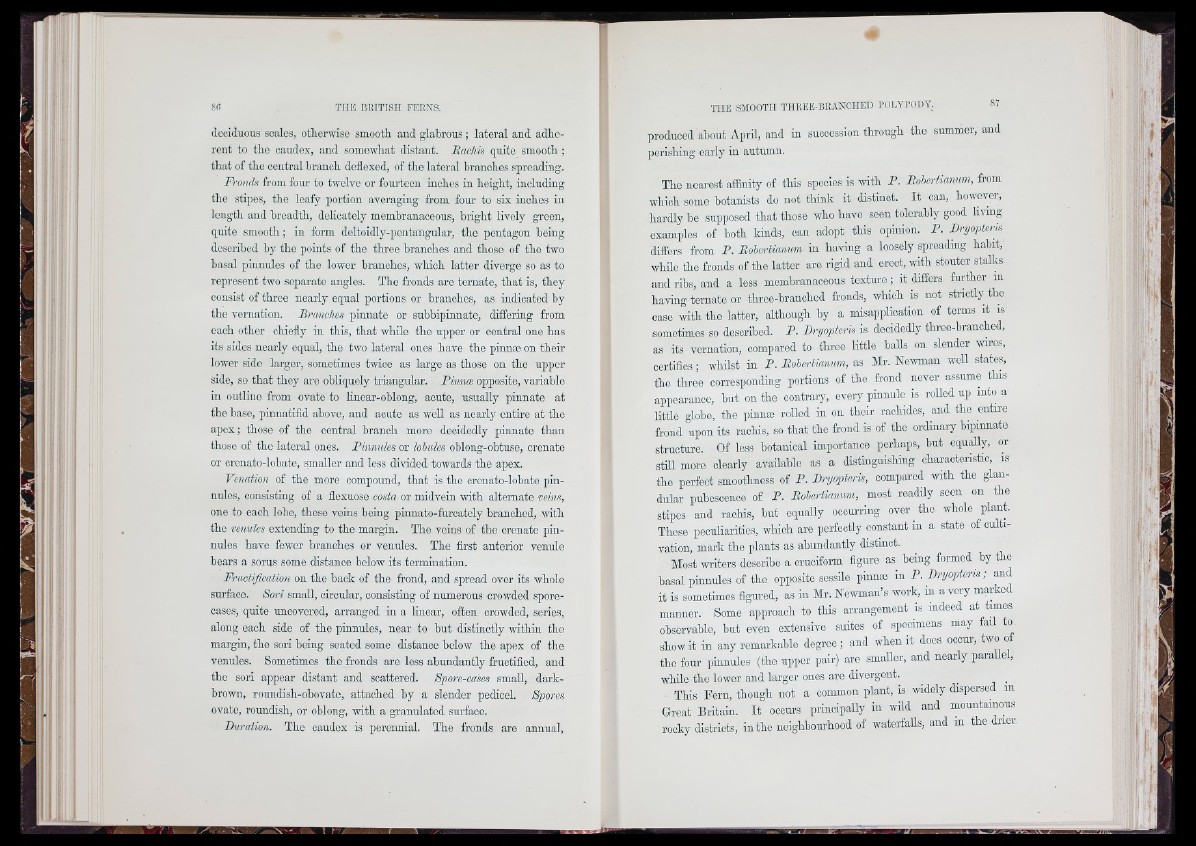
deciduous scales, otherwise smooth and glabrous ; lateral and adherent
to tho caudox, and somewhat distant. Rachis quite smooth ;
that of tho central branch dcfloxod, of tho lateral branches spreading.
Fronds from four to tAVolvo or fourtooii inches in height, including
the stipes, tho leafy portion averaging from four to six inches in
length and breadth, delicately membranaceous, blight lively green,
quite smooth ; in form doltoidly-pontangular, the pentagon hoing
described by tho points of the threo branches and those of tho two
basal pinnules of tbo lower branches, which latter diverge so as to
represent two separate angles. The fronds are tomato, that is, they
consist of three nearly equal portions or branches, as indicated by
tho vernation. Branches pinnate or subbipinnato, differing from
each other chiefly in this, that while the upper or central one has
its sides nearly equal, the two lateral ones have the pinnæ on their
lower side larger, sometimes twice as largo as those on tho upper
side, so that they aro obliquely triangular. Rinnce opposite, variable
iu outlino from ovate to linoar-oblong, acute, usually pinnate at
tlie base, pinnatifid above, and acute as woll as nearly entire at tlio
apex; those of tho central branch more dooidodly pinnate than
those of the lateral ones. Pinnules or lohules oblong-obtuse, cronato
or crcnato-lohate, smaller and less divided towards the apox.
Venation of tho moro compound, that is tho crcnato-lohate pinnules,
consisting of a floxuoso costa or midvein with alternate veins,
one to each lobe, these veins boing pinnato-furoatoly branched, with
the venules extending to the margin. Tho veins of the crcnate pinnules
havo foAver branches or venules. Tho first anterior vcnulo
bears a sorus some distance bcloAV its termination.
Fructification on tho hack of the frond, and spread over its whole
surface. Sori small, circular, consisting of numerous crowded sporo-
casos, quite uncovered, arranged in a linear, often crowded, series,
along each side of the pinnules, near to but distinctly Avithiii tho
margin, tho sori boing seated some distance below the apex of tho
venules. Sometimes the fronds aro less abundantly fructified, and
the sori appear distant and scattered. Sporo-cases small, dark-
brown, roundish-obovato, attached by a slender pedicel. Spores
ovate, roundish, or oblong, Avith a granulated surface.
Duration. Tho caudex is perennial. The fronds aro annual,
produced about April, and in succession through tho summer, and
perishing early iu autumn.
The nearest affinity of this species is Avith T . Rohertiannm, from
which some botanists do not think it distinct. I t can, hoAvovor,
hardly he supposed that those Avho havo scon tolerably good living
examples of both kinds, can adopt this opinion. P . Dryopteris
differs from P . Rohcrtianum in having a loosely spreading hahit,
whilo tho fronds of tho latter are rigid and erect, whh stouter stalks
and ribs, and a loss membranaceous texture ; it differs further m
having tomato or throe-branched fronds, Avhich is not strictly the
case Avith tho latter, although hy a misapplication of terms it is
sometimes so described. P . Dryopteris is decidedly tbrco-branohcd,
as its vernation, compared to tbroc littlo balls on slender wires,
certifies ; Avhilst in P . Rohertianim, as Mr. NoAvman well states,
the tbrco corresponding portions of tho frond never assume this
appearance, hut on tho contrary, every piniiulo is roUcd up into a
littlo globe, tbe pinnæ rolled in on thoir rachides, and the entire
frond upon its rachis, so that the frond is of tho ordinary bipmnatc
structure. Of less botanical importance perhaps, but cquaUy, or
still more clearly available as a distinguisbing cbaracteristic, is
tbe perfect smoothness of P . Dryopteris, compared Avith the glandular
pubescence of P . Robertianum, most readily soon on tlio
stipes and rachis, hut equally occurring over the whole plant.
These peculiarities, Aiteich aro perfectly constant in a state of cultivation,
mark tho plants as abundantly distinct.
Most Avritcrs describe a cruciform figure as being formod by tbo
basal pinnules of tbe opposite sessile pinnæ in P . Dryopteris ; and
it is sometimes figured, as in Mr. Newman’s work, in a very maricod
manner. Some approach to tliis arrangemont is indeed at times
observable, but even extensive suites of specimens may iaü to
show it in any remarkable degree ; and Avhen it does occur, two of
the four pinnules (the upper pair) aro smaller, and nearly parallel,
while the lower and larger ones aro divergent. ^ ^
This Fern, though not a common plant, is AAudoly dispersed in
Groat Britain. I t ooours principally in Avild and mountainous
rocky districts, in tho neighbourhood of waterfalls, and in the drier
Î
IT i'J ’
'i! !
ii 3